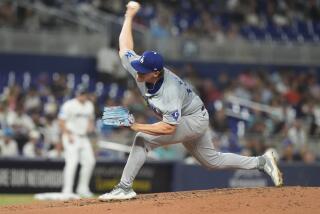For a Price, Marlins Could Be Winners
- Share via
They call them “protected lists,” and 26 of them were dispatched to the spanking new offices of the Florida Marlins and the Colorado Rockies this week.
They were considered confidential material. Classified information. Top secret. Not to be revealed under penalty of fine, suspension, imprisonment, deportation or Seattle Mariners season tickets.
What that meant, of course, was that we had to wait 48 hours for the lists to be leaked to the press, instead of the usual 24.
The revelations have been startling. The last time baseball expanded, in 1977, the Toronto Blue Jays and the Seattle Mariners wound up drafting a bunch of guys named Otto Velez and Juan Bernhardt. It was a vintage year for utility infielders, pinch-hitters and long relievers who had never seen the light of a 3-2 ballgame.
But in 1977, free agency was still an alluring, but somewhat, frightening new toy; arbitration was but a twinkle in the eye of Marvin Miller; whole lineups made $7 million a year instead of just the second baseman; the golden goose called “television” hadn’t yet contracted emphysema; and contract-dumping hadn’t replaced golf as the No. 1 recreational activity among owners and general managers.
Now, when assigned to protect 15 players and subject the remainder to the whims of the expansion pool, front office staffs are bypassing the traditional “best athlete available” in favor of the “best value available” and dangling enough big-salaried big names to furrow the brow of St. Louis Cardinal General Manager Dal Maxvill with fret.
Assessing the currently depressed state of the National League East and the quality of talent available to the Marlins, Maxvill says he fears the worst, which would be a first:
Florida could win the NL East in its first season, Maxvill contends, if it drafts to win now and is willing spend tens of millions of Wayne Huizenga’s Blockbuster Video fortune.
Potentially, this could be the nucleus of the 1993 Florida Marlins roster:
First base: Eddie Murray.
Second base: Jose Lind.
Third base: Tim Wallach.
Shortstop: Shawon Dunston.
Left field: George Bell.
Center field: Ellis Burks.
Right field: Danny Tartabull.
Catcher: Greg Olson.
Starting pitcher: Jack Morris.
Starting pitcher: Tom Browning.
Starting pitcher: Bruce Hurst.
Starting pitcher: Bud Black.
Relief pitcher: Bryan Harvey.
Relief pitcher: Lee Smith.
So who do you like in the NL East next year?
The Montreal Expos?
And where do the Angels re-apply for expansion?
These men could be Marlins, because all of them were left unprotected by their present employers and will be made available in the first round. Since none of them currently play for the same team--no existing team can lose more than one player in the first round--Florida, conceivably, could draft them all.
Paying them would be the hitch. How high could the Marlin payroll fly? Do I hear $50 million? $60 million? $70 million?
That’s a lot of copies of “My Cousin Vinny” to move.
For Florida General Manager Dave Dombrowski, the temptation to go for all of it, or some of it, and swap 1998 for 1993 must be powerful. Look at the NL East, circa mid-November, ’92. The three-time champion Pittsburgh Pirates are on the verge of losing their best player, Barry Bonds, and their best pitcher, Doug Drabek, to free agency. Montreal won 87 games on an adrenaline lift from Felipe Alou. Will it wear off by next April? And after St. Louis (83-79), no other team in the division broke even.
The Marlins could become major players, right away, if they are willing to pay the price.
Twenty-six teams are betting that the Marlins won’t, rolling the dice that they and the Rockies will behave like good little expansion teams and plan for the future and draft a good many prospects who will play for the major-league minimum.
That’s why the Chicago White Sox, gearing up for a push to win the American League West in ‘93, decide to leave Bell (112 RBIs), relief ace Bobby Thigpen, second baseman Steve Sax and starting pitchers Greg Hibbard and Kirk McCaskill off their protected list.
And, to an extent, that’s why the Angels are making Harvey, their top relief pitcher, available. Essentially, the Angels are playing chicken with the Marlins and the Rockies: “Harvey has a $10.75-million contract and just had elbow surgery. Go ahead. We dare you to draft him.”
Luis Polonia is another story, one that could very well backfire on the Angels. Polonia is a make-something-happen leadoff hitter in the prime of his career (he’s 28) and not paid an outrageous sum ($1.6 million). But the Angels fear arbitration--after 51 stolen bases and a team-MVP season, Polonia could double that salary in arbitration--and make no mistake about the Angels’ so-called “youth movement.” First and foremost, it’s an economy movement.
Then, too, the Angels also fear the Marlins’ coaching staff, headed by former Angel pitching coach Marcel Lachemann and recently augmented by former Angel managers Doug Rader and Cookie Rojas. (Gene Mauch, apparently, was out golfing and couldn’t be reached.) Besides telling old Greg Minton stories, Lachemann, Rader and Rojas can also compare notes--and Lachemann, in particular, knows where the Angel prospects are buried.
So the Angels scramble and gamble on Harvey and Polonia so they can protect three minor-league pitchers, including 24-year old Ron Watson, who spent 1992 at Class-A Quad Cities.
At any rate, Tuesday figures to be the most awesome Rotisserie draft of all time. How will the Rockies and the Marlins handle it?
Their credit line’s the limit.
More to Read
Go beyond the scoreboard
Get the latest on L.A.'s teams in the daily Sports Report newsletter.
You may occasionally receive promotional content from the Los Angeles Times.










